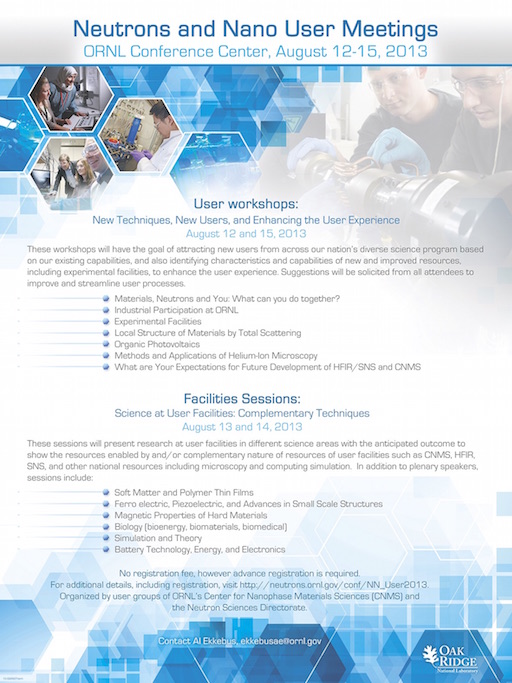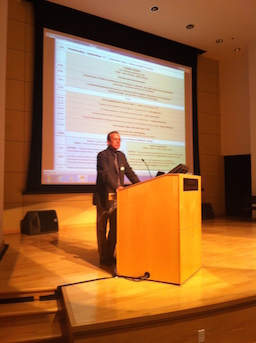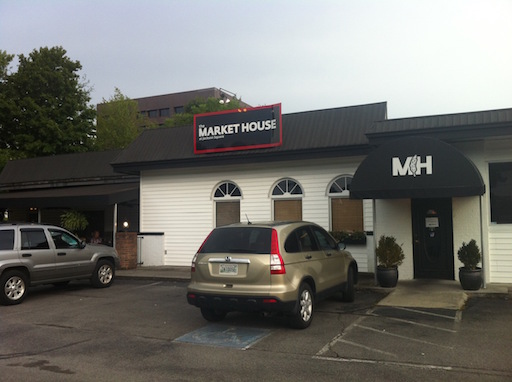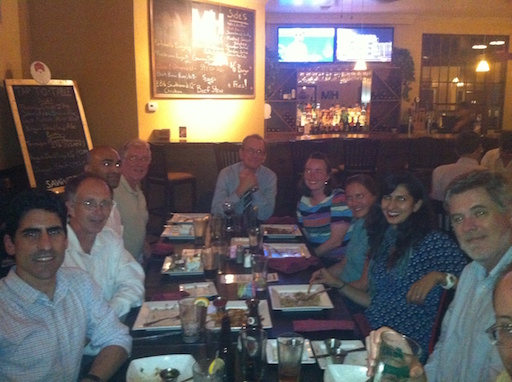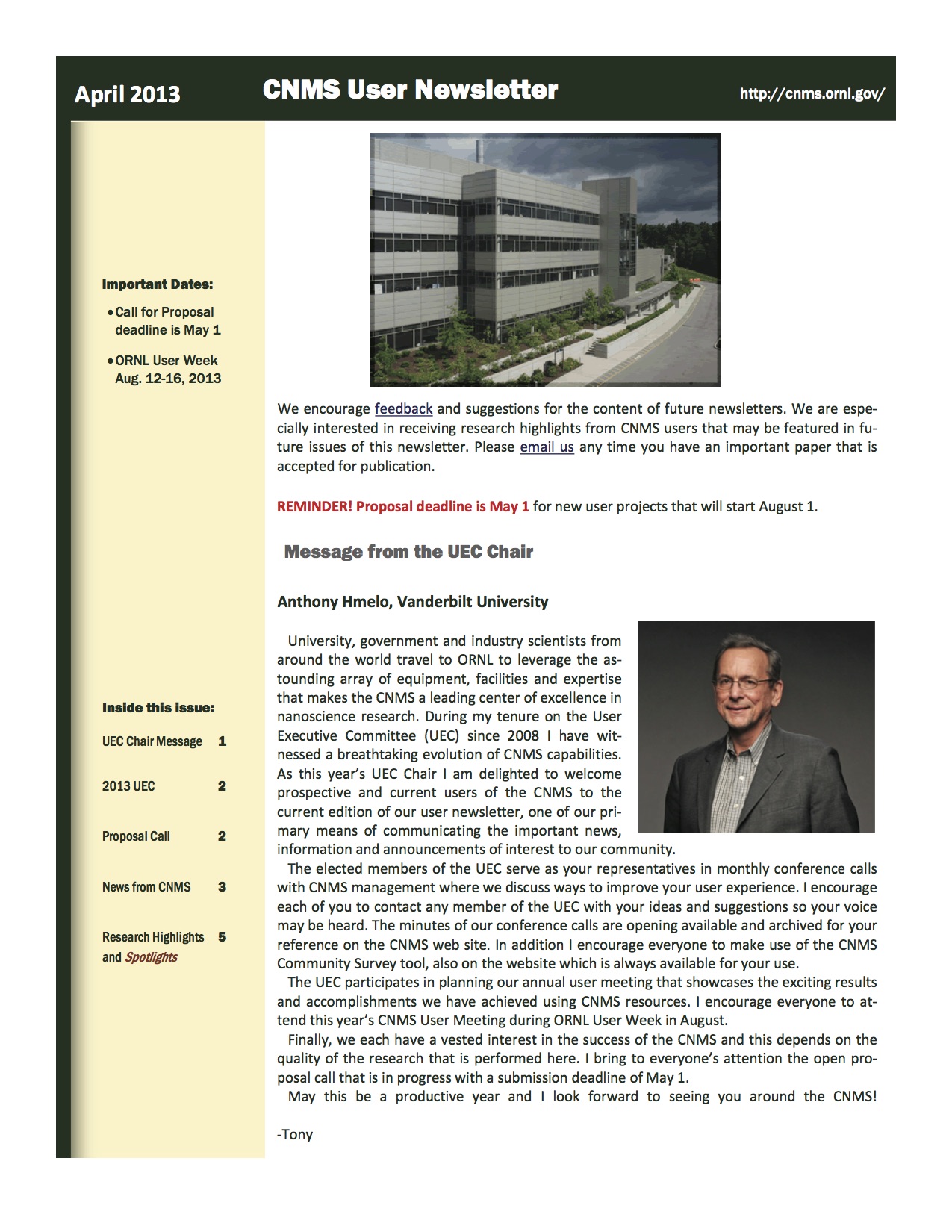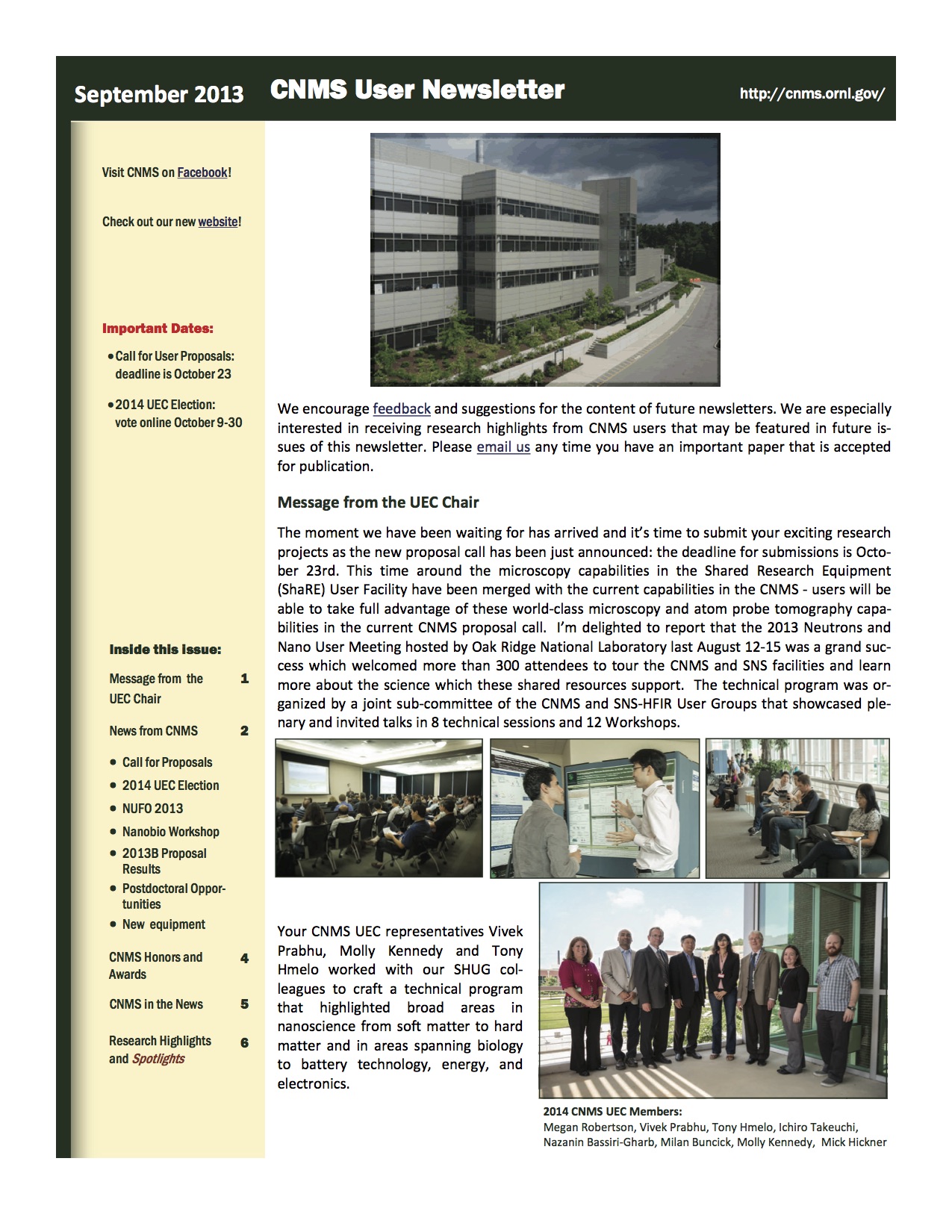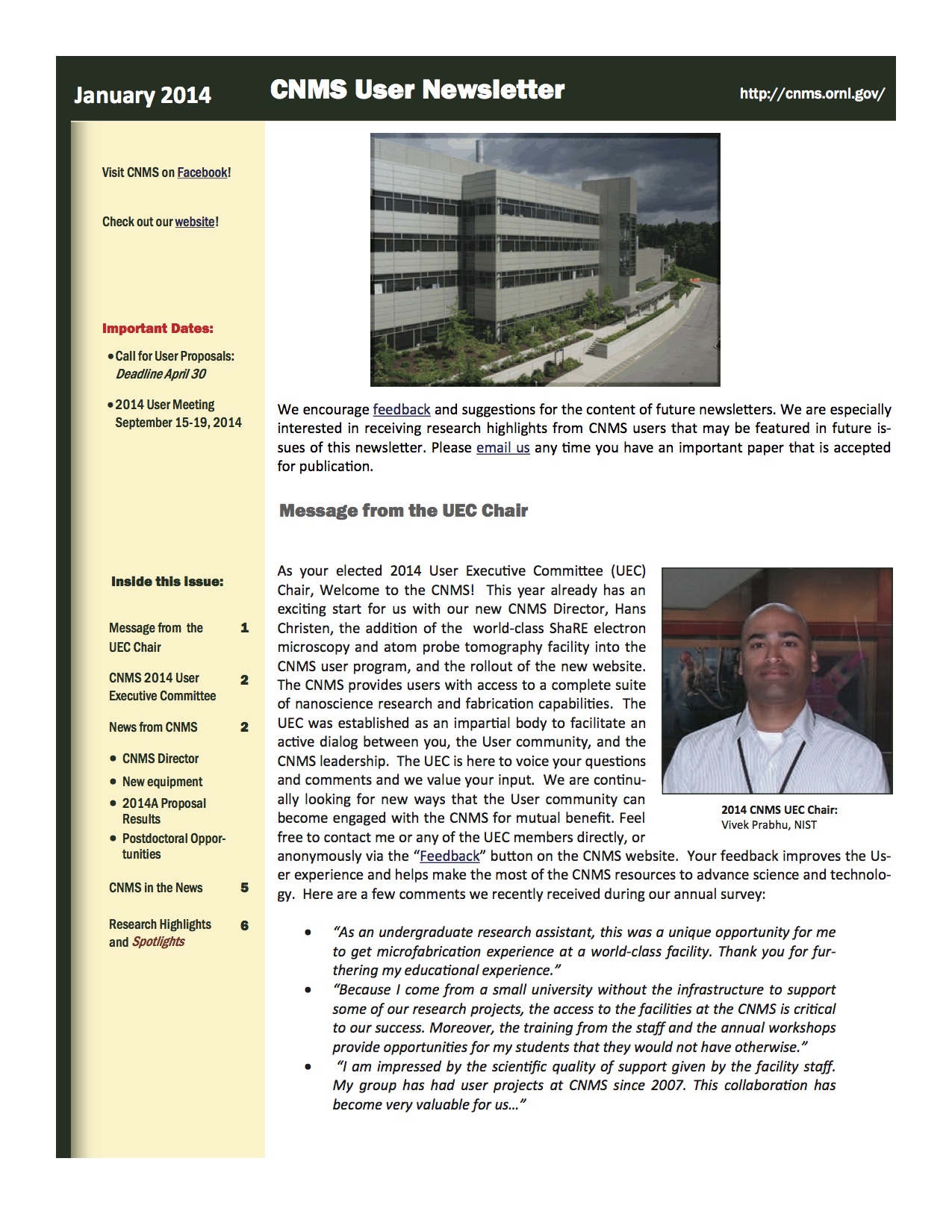Center for Nanophase Materials Sciences (CNMS) 2003 – 2014
Center for Nanoscale Materials Science at ORNL
Professor Hmelo has represented the CNMS user community and Vanderbilt University during a long-standing relationship with the CNMS not only as a customer of its facilities, but as a member and officer of the User Executive Committee (UEC) in various capacities over a term of years, as outlined below:
Elected Membership in the User Executive Committee (2006-2014)
2006 - 2010 Member-at-Large 2011 Secretary 2012 Vice-Chair 2013 Chair 2014 ex-officio
Membership of the 2013 User Executive Committee
Nina Balke (At-large, CNMS/ORNL)
Nazanin Bassiri-Gharb (At-large, Georgia Tech)
Milan Buncick (Secretary, Aegis Technologies Group)
Tony E. Haynes (User Program Manager, CNMS)
Michael Hickner (At-large, Penn State)
Anthony Hmelo (Chair, Vanderbilt)
Marian Kennedy (At-large, Clemson)
Martyn A McLachlan (ex-chair, London Imperial College)
Vivek Prabhu (Vice Chair, NIST)
Megan Robertson (At-large, University of Houston)
Ichiro Takeuchi (At-large, Univeristy of Maryland)
Rafael Verduzco (At-large, Rice)
About the User Executive Committee: Functions and Procedures (quoted from the charter):
The Executive Committee shall carry out the following functions and procedures:
• The Executive Committee, reflecting the sentiment of the membership, shall make recommendations to CNMS management on matters affecting the user community such as operating policies, operating hours for specific instruments, and needs for facilities, infrastructure, and instrumentation.
• The Executive Committee, acting on suggestions from the CNMSUG membership, shall make recommendations to CNMS management for persons to serve on proposal evaluation committees.
- The Executive Committee shall plan the annual meeting of the CNMSUG.
- The Executive Committee shall report back to the membership at the annual meeting and at other times as appropriate.
• The Chair or Vice-Chair of the CNMSUG will serve as an ex officio member of the CNMS Advisory Committee.
Officers (general guidelines, not explicit in the charter)
(All terms of office are one year. However, at the end of each year the Vice-Chair will succeed to Chair for one additional year of service and the Chair will continue as ex officio member for one year.)
A. Chair- (1) Call, organize, and preside over meetings, conference calls, and discussions of the UEC deemed necessary to accomplish its goals; (2) Serve as an ex officio member of the CNMS Advisory Committee, which is the senior advisory body for the science program at the CNMS and is appointed by ORNL management; (3) Serve as the principal spokesperson speaking to CNMS management on behalf of the broader CNMSUG membership; (4) remain as ex officio member of the UEC for one year following the expiration of term as Chair.
B. Vice-Chair- (1) Fulfill the duties of the Chair at times when the Chair may be temporarily unable to carry out those duties; (2) Assume the position of Chair if the office of Chair becomes vacant during the year; (3) Succeeds to the office of Chair at the conclusion of the Chair’s original term of office. (The Vice-Chair serves as Vice-Chair for one year and Chair for the subsequent year.)
C. Secretary- (1) Maintains records of UEC meetings and actions; (2) Manage the annual election of new officers, including the collection of nominations, distribution of information, and reporting of results [Administrative support for these activities may be provided by CNMS management upon request.]
D. At-Large- (1) Attend meetings, conference calls, and discussions called by the Chair; (2) Vote as a member of the UEC on the adoption of resolutions, recommendations, and CNMSUG action plans; (3) serve on and/or chair occasional ad hoc committees that may be organized by the UEC in accordance with its charter.
2013 User Executive Committee (UEC)
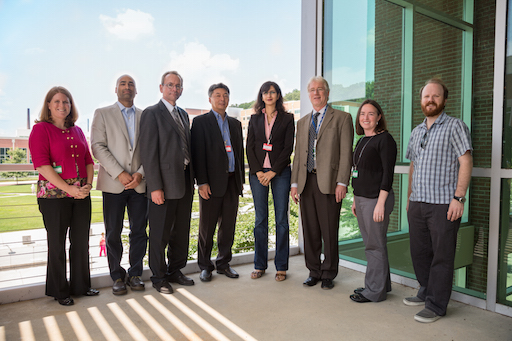
Notable accomplishments of the 2013 UEC
2013 NUFO Exhibition in Washington DC (June 2013)
Vice Chair Vivek Prabhu (NIST), Professor Molly Kennedy (Clemson) and Professor Hmelo visited Washington on behalf of the National User Facilities Organization (NUFO) representing CNMS to advocate for increased support for CNMS and other similar user facilities. We met with the staff of the following congressional offices:
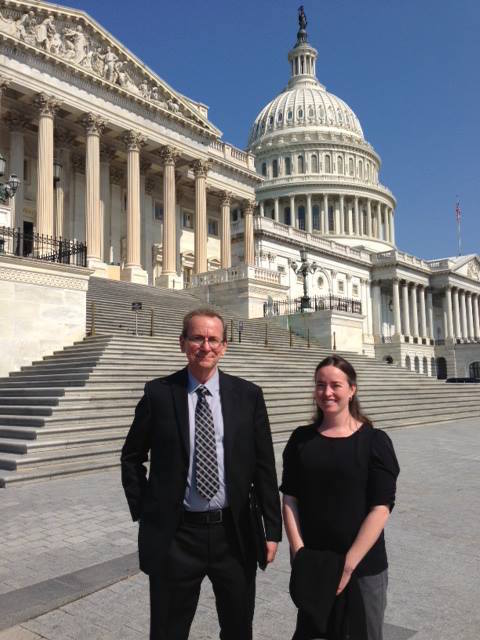
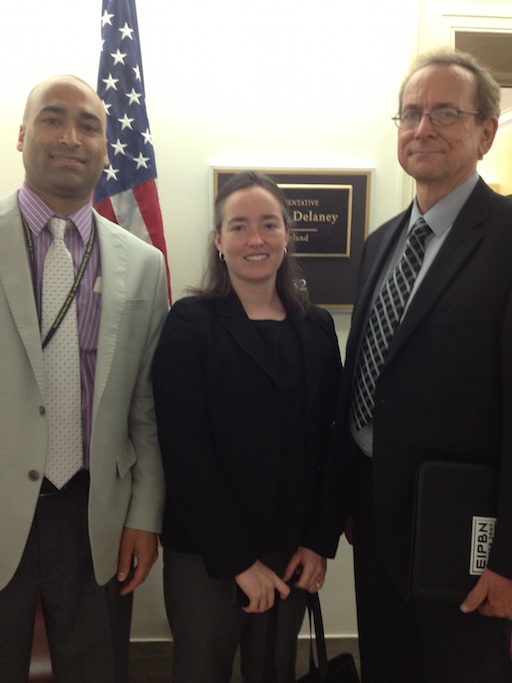
Neutrons and Nano Workshops and User Meetings (August 12-15, 2013)
The Neutrons and Nano User Meetings in 2013 were a joint venture between the users of CNMS and the Spallation Neutron Source (SNS) co-organized with Greg Beaucage (SNS, University of Cincinnati). This meeting was a grand success with over 300 attendees, a record attendance for a user meeting up until that date.
2nd Annual CNMS UEC Informal Dinner Gathering (August 12, 2013)
On the first evening of the user meeting members of the UEC, and CNMS management, gathered for an informal gathering at the Market House restaurant in Oak Ridge to socialize and celebrate our accomplishments during the previous year.
SHaRE Integration (Late 2013)
The Shared Research Equipment (SHaRE) User Facility was formally integrated with CNMS to bring Electron Microscopy, Atom Probe Tomograpy, and X-ray Scattering instruments under the management of CNMS and incorporated into an integrated user proposal process.
Basic Energy Sciences (BES) Triennial Review (September 25, 2013)
Five member of the UEC (Tony Hmelo (chair), Nina Balke, Nazanin Bassiri-Gharb, Milan Buncick, and Molly Kennedy) met with reviewers from BES to discuss our experiences at the CNMS and to answer their questions regarding the operation and management of CNMS.
2013 CNMS User Newsletters
Legacy of the 2013 UEC
During his term as Chair, the 2013 UEC substantially deepened its relationship with CNMS management as a deliberative and consultative body.
Professor Hmelo’s Research at CNMS
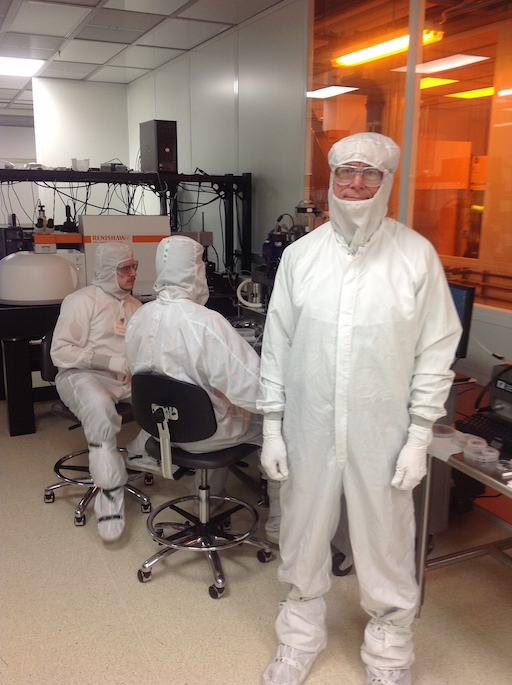
Professor Hmelo has led three successful user proposals at the CNMS:
Title: CNMS2007-258 Nanofluidic Device Fabrication for Research in Transverse Current Sequencing of DNA
Abstract: The PI and collaborators have been funded by NIH to build a nanofluidic device to sequence single stranded DNA. Can we use transverse current sensing across a molecule confined in a nanofluidic channel to distinguish individual base pairs? Quantum mechanical calculations support this approach, however these are controversial. Experimental evidence is needed to determine the efficacy, resolve the debate, and develop the procedures which can enable the revolution that promises to transform medicine into a genome-based practice. This work will explore a proposed technique for fabrication of the nanofluidics device needed to realize this research.
Title: CNMS2006-039 Electrical conductivity mapping of FIB patterned semiconductors and insulators using the cryogenic 4-probe STM
Abstract: We seek to quantify and understand the nanoscale electrical conductivity of FIB modified nanostructures in intrinsic silicon and insulating materials such as SiO2 from cryogenic to room temperature. What is the transfer function for experimentally observed electrical conductance as as function of implanted Ga dose, particularly at the lower limit? We will provide a matrix of specially prepared specimens of silicon and glass that have been patterned using the FEI FIB 200 at Vanderbilt University and vary both the annealing temperature, and applied Ga dose from 10^12 cm-2, the minimum dose we can implant, to 10^16cm-2, achieved as the implanted rate approaches the sputter rate for deep structures. Nanoscale geometries will be varied from single lines as narrow as 10 nm wide, to channels up to 500 nm square cross-section. We will correlate 4-probe STM measurements of the nanoscale electrical conductivity of Ga implanted substrates with the concentration and depth distribution of implanted Ga as determined by Rutherford Backscatter Spectroscopy (RBS) performed at Vanderbilt University.
Title: CNMS2003-039 Nanofabrication of Ion Channel Arrays for use as Artificial Cell Receptors
Abstract: The main scientific question we address is the interfacing of biologically active materials with inorganic materials, mainly silicon, to create a new class of sensors for environmental sensing of contaminants and chemical and biological warfare agents, in-situ clinical monitoring, and drug discovery. The fundamental questions deal with the critical interface issues of creating fluidic channels at the nanoscale and coupling these channels to biologically active elements. The notion is to form a nanoscale receptacle from hard materials such as silicon or glass into which transmembrane proteins, e.g., ligand gated ion channels can be inserted. Ligand gated ion channels have the property that their conductance can be increased or decreased when an appropriate ligand binds with receptors on the ion channel. The coupling of ion channels with a silicon device could result in a nanoscale chemical sensor that can be very robust compared to a cell, the normal receptacle for transmembrane protein assembles.
What are the activities of the UEC today?
Current information about CNMS operations and the activities of the User Executive Committee and be found here.
